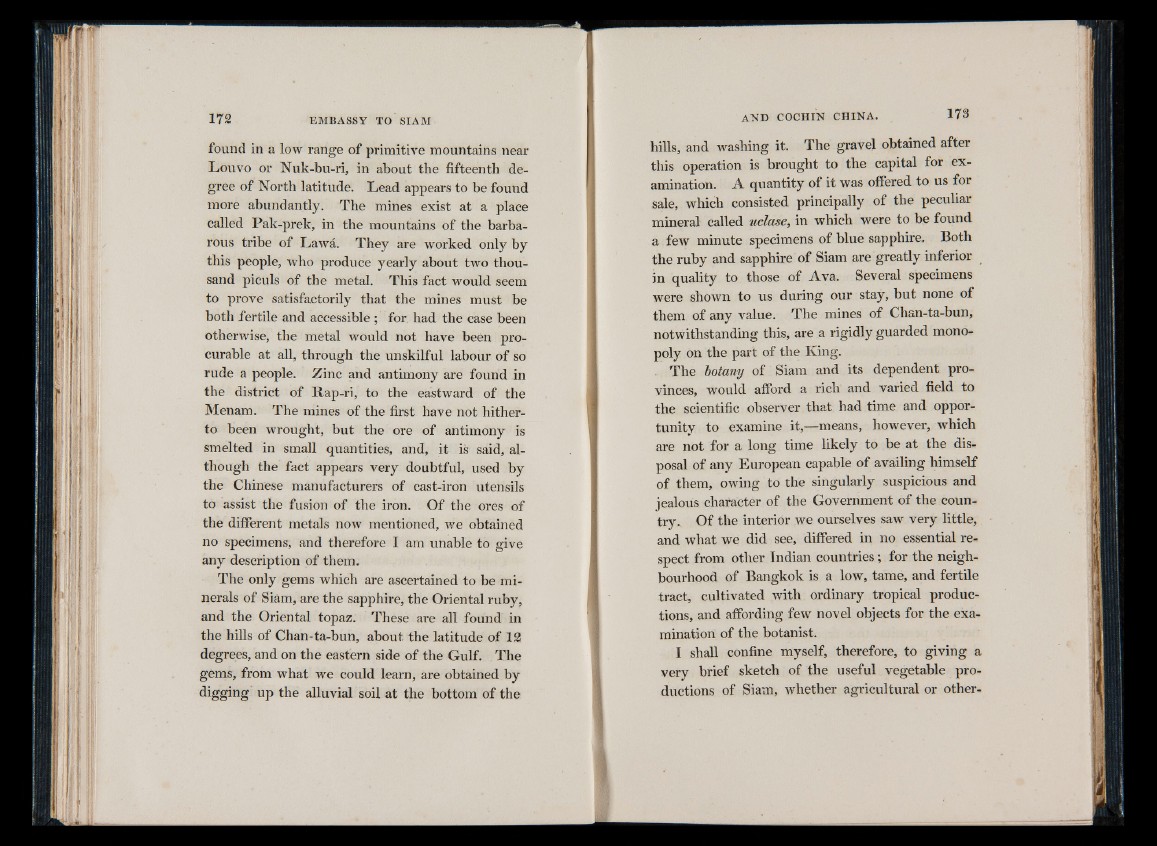
found in a low range of primitive mountains near
Louvo or Nuk-bu-ri, in about the fifteenth degree
of North latitude. Lead appears to be found
more abundantly. The mines exist at a place
called Pak-prek, in the mountains of the barbarous
tribe of Lawa. They are worked only by
this people, who produce yearly about two thousand
piculs of the metal. This fact would seem
to prove satisfactorily that the mines must be
both fertile and accessible ; for had the case been
otherwise, the metal would not have been procurable
at all, through the unskilful labour of so
rude a people. Zinc and antimony are found in
the district of Hap-ri, to the eastward of the
Menam. The mines of the first have not hitherto
been wrought, but the ore of antimony is
smelted in small quantities, and, it is said, although
the fact appears very doubtful, used by
the Chinese manufacturers of cast-iron utensils
to assist the fusion of the iron. Of the ores of
the different metals now mentioned, we obtained
no specimens, and therefore I am unable to give
any description of them.
The only gems which are ascertained to be minerals
of Siam, are the sapphire, the Oriental ruby,
and the Oriental topaz. These are all found in
the hills of Chan-ta-bun, about the latitude of 12
degrees, and on the eastern side of the Gulf. The
gems, from what we could learn, are obtained by
digging up the alluvial soil at the bottom of the
hills, and washing it. The gravel obtained after
this operation is brought to the capital for examination.
A quantity of it was offered to us for
sale, which consisted principally of the peculiar
mineral called uclase, in which were to be found
a few minute specimens of blue sapphire. Both
the ruby and sapphire of Siam are greatly inferior
in quality to those of Ava. Several specimens
were shown to us during our stay, but none of
them of any value. The mines of Chan-ta-bun,
notwithstanding this, are a rigidly guarded monopoly
on the part of the King.
The botany of Siam and its dependent provinces,
would afford a rich and varied field to
the scientific observer that had time and opportunity
to examine it,—means, however, which
are not for a long time likely to be at the disposal
of any European capable of availing himself
of them, owing to the singularly suspicious and
jealous character of the Government of the country.
Of the interior we ourselves saw very little,
and what we did see, differed in no essential respect
from other Indian countries ; for the neighbourhood
of Bangkok is a low, tame, and fertile
tract, cultivated with ordinary tropical productions,
and affording few novel objects for the examination
of the botanist.
I shall confine myself, therefore, to giving a
very brief sketch of the useful vegetable productions
of Siam, whether agricultural or other